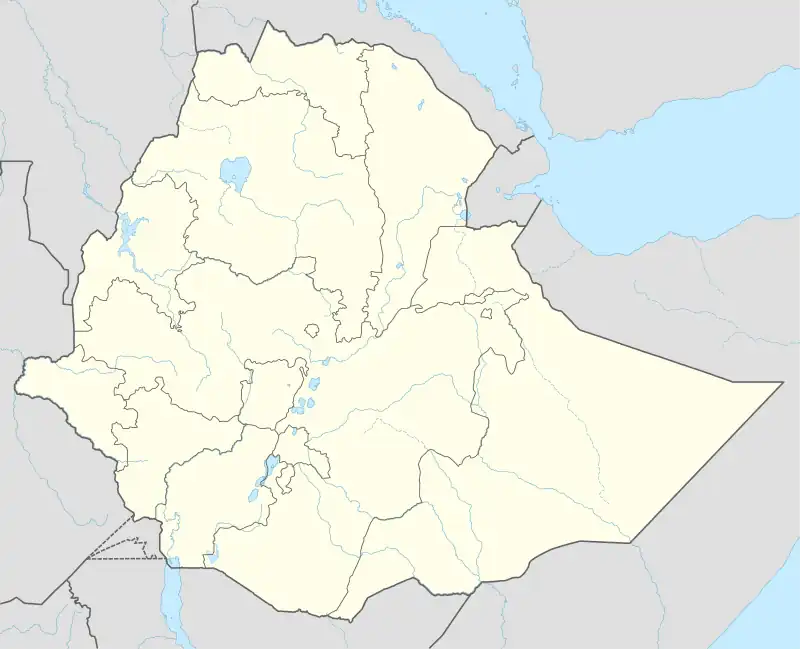 | |
| UTC time | |
|---|---|
| 1969-03-29 09:15:53 | |
| 1969-03-29 11:04:50 | |
| 1969-04-05 02:18:31 | |
| ISC event | |
| 811663 | |
| 811667 | |
| 809572 | |
| USGS-ANSS | |
| ComCat | |
| ComCat | |
| ComCat | |
| Local date | |
| March 29, 1969 | |
| March 30, 1969 | |
| April 05, 1969 | |
| Local time | |
| 12:15:53 | |
| 02:04:50 | |
| 05:18:31 | |
| Magnitude | |
| 6.2 Mw | |
| 6.1 Mw | |
| 6.1 Mw | |
| Depth | 10 km |
| Areas affected | Ethiopia |
| Max. intensity | VIII (Severe) – IX (Violent) |
| Casualties | 20–40 fatalities, 160 injuries |
The 1969 Sardo earthquakes, which occurred from March 29, 1969 to April 05, 1969 was an earthquake swarm of three events with magnitudes of 6.2 Mw and 6.1 Mw in the Afar Region, Ethiopia. All three tremors had estimated intensities of between IX (Violent) and VIII (Severe) respectively. It killed a total of about 20–40 people and further injuring 160 as well.[1][2][3][4]
Tectonic setting
The Afar Region is set in a tectonic boundary with three plates in a Y-shaped configuration. This makes Ethiopia home to one of the most seismic regions in all of Africa. It is also located in the Main Ethiopian Rift, part of the greater East African Rift which have been known to have been where frequent geological activity, one of the most common is the possible separation of East Africa from the mainland. The Main Ethiopian rift is a central valley some 84km wide and is extending ESE-WNW at a rate of about 2.5mm/yr. Ethiopia has experienced numerous earthquake similar to this such as in 1961 and 1847.[4][5]
Earthquakes
The first of the earthquake sequence had a magnitude of 6.2 and was the most destructive of the three causing the 20-40 deaths and 160 injuries as well as most of the damage. The second and third earthquakes both with magnitudes of 6.1 were fortunately less worse however still caused some damage and recorded with high intensities. Numerous surface faultings and displacement were also caused, the main event caused left-lateral displacements and throws northeast of 75 cm near Sardo. The April event also caused visible surface faultings near Sardo with 70 cm vertically and 50 cm horizontally.[4][6][7]
Damage
The village of Sardo (Serdo) suffered most of the impact due to it being the nearest to the epicenter. Poor infrastructure and framing was said to be blamed for the widespread severity of the damage. Some of the local huts in the area were made mostly of mud, which also resulted in the many deaths. The sequence triggered numerous rockslides blocking roads and transportation between the other parts of Ethiopia, as well as the outside in nearby Djibouti where moderate jolts were felt. Many of the residents who survived the event fled to the nearby village of Loggia.[4]
See also
References
- ↑ "M 6.2 - 20 km NE of Dubti, Ethiopia". earthquake.usgs.gov. Archived from the original on 2021-10-20. Retrieved 2021-10-20.
- ↑ "M 6.1 - 33 km ENE of Dubti, Ethiopia". earthquake.usgs.gov. Archived from the original on 2021-10-20. Retrieved 2021-10-20.
- ↑ "M 6.1 - 32 km ENE of Dubti, Ethiopia". earthquake.usgs.gov. Archived from the original on 2021-10-20. Retrieved 2021-10-20.
- 1 2 3 4 "NCEI Global Historical Hazard Database". www.ngdc.noaa.gov. Retrieved 2021-10-20.
- ↑ Fairhead, J. D.; Girdler, R. W. (1970). "The Seismicity of the Red Sea, Gulf of Aden and Afar Triangle". Philosophical Transactions of the Royal Society of London. Series A, Mathematical and Physical Sciences. 267 (1181): 49–74. Bibcode:1970RSPTA.267...49F. doi:10.1098/rsta.1970.0023. ISSN 0080-4614. JSTOR 73608. S2CID 91495612.
- ↑ "Earthquakes Report". iisee.kenken.go.jp. Retrieved 2021-10-20.
- ↑ "Today in Earthquake History". earthquake.usgs.gov. Retrieved 2021-10-20.